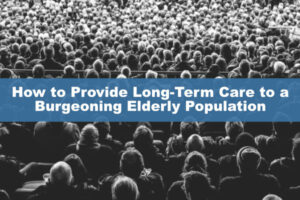How to Provide Long-Term Care to a Burgeoning Elderly Population

Providing long-term care to a Burgeoning Elderly Population isn’t the problem. We know how to do that. Paying for it is.
Providing long-term care isn’t the problem. We know how to do that. Paying for it is.
So, I’m going to define the long-term care financing problem. Both government and scholars have focused corrective action on symptoms of the problem instead of its causes.
Long-term care for our Burgeoning Elderly Population includes a broad range of social, medical and custodial services that caregivers provide for three months or longer to help disabled people of any age perform activities of daily living such as eating, bathing, and toileting. Our focus is long-term care for the aged.
Let’s briefly restate that the this is a big issue. You know we have an aging baby boom generation. The numbers of beneficiaries already stressing Medicare and Social Security. They’ll overwhelm Medicaid, the dominant long-term care payer, when they start turning 85 in 2031. The U.S. age 85+ population, the cohort with the highest long-term care need, will triple between 2015 and 2050.
After age 65, people have a 70% probability of needing extended care, and a 5% probability that long-term care users will need ten years or more costing hundreds of thousand–even millions–of dollars. That there’s this gap between the number who need care at all and those who need extended care makes it possible to obtain insurance to protect you.
Care is very expensive wherever it is provided.
On average, nursing homes charge $9,500 to $11,000 per month. Assisted Living costs $4,000 to $6,500 per month; dementia care can easily reach $8,500 or more. The U.S. spent $366 billion on facility-based long-term care in 2016. Families and friends provided an additional half-a-trillion dollars’ worth of unpaid care, at huge financial and emotional distress.
Family-provided care is not free. It requires much time off from work, early retirements, declined transfers and promotions, and a surprising amount of out-of-pocket incidentals. Then there is Medicaid, a welfare program that favors nursing homes (just where you do not want to end up) because most assisted living facilities no longer are willing to accept its woefully inadequate reimbursement rates.
When people think care is free on Medicaid (welfare), they don’t prepare. Once they find they are not welcomed where they want care delivered, it is too late to qualify for the insurance that can pay for care. Medicaid takes more and more of your tax dollars, provides inadequate reimbursement for care – limiting your options of where you will be cared for, and makes you think you don’t need insurance.
Is the insurance prohibitively expensive as many mistakenly think? Not when it is chosen appropriately. There is no need to purchase enough to cover the entire bill. (An analogyis auto insurance–do you have 100% coverage for your car, or did you choose a deductible?) Once you determine how much of the cost of care you can comfortably pay for yourself, you only need to buy enough LTC insurance to make up the difference.
A 50-year-old can buy coverage that will provide $9000 a month for one year of care ($108,000 total) for a premium of just $214 per year. A 65-year-old can purchase $850,000 of coverage for less than $2000 a year.
If you want choices of where you might receive care, if you do not want to spend your entire nest egg on care, if you want to leave something other than your funeral bill to your family, perhaps you should investigate LTC insurance. But, do it with an expert who knows the costs, how and where care is delivered, and how to choose appropriate coverage.
Romeo Raabe LUTCF, LTCP known as TheLongTermCareGuy.com has been helping people choose appropriate LTC insurance coverage for 26 years. He can be reached at (920) 884-3030.
